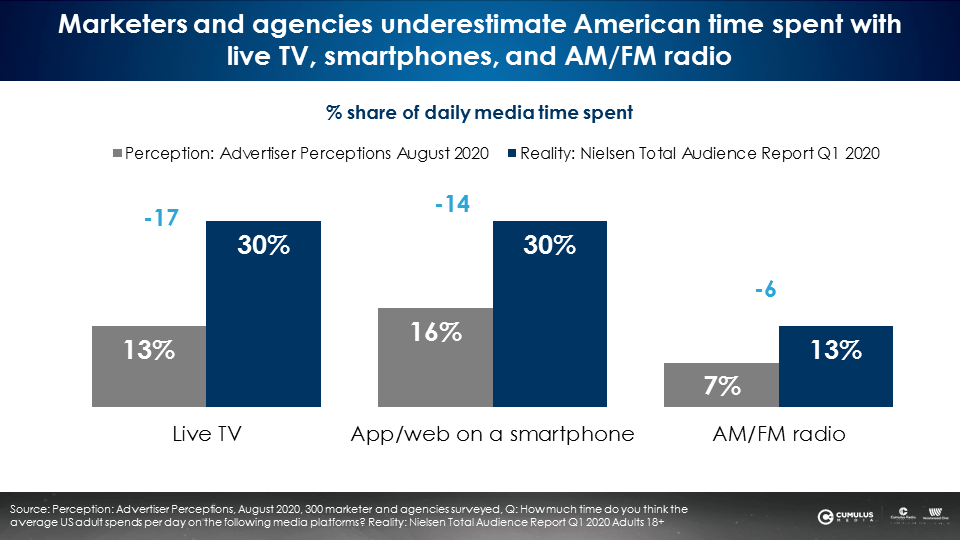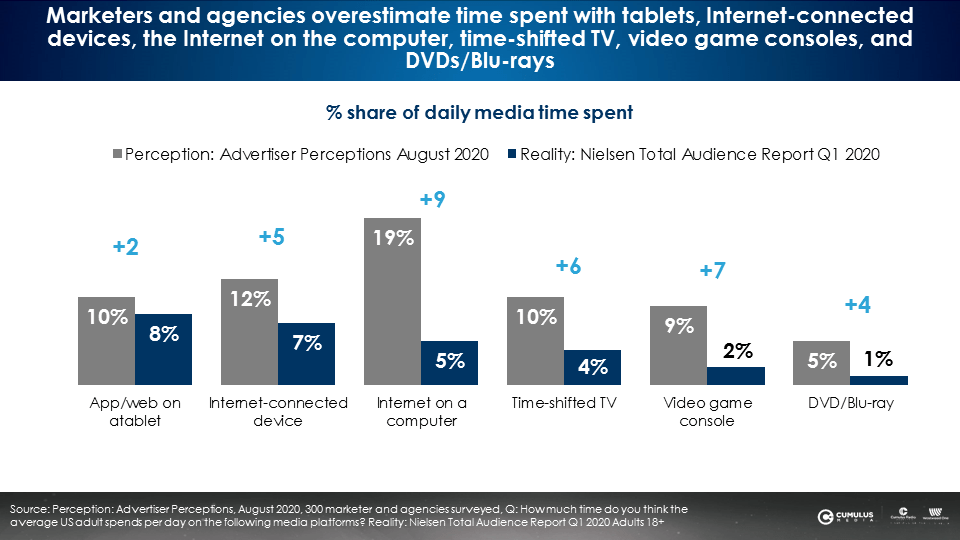Marketers/Agencies: Take the “Me” Out of “Media”
How much time do American consumers spend each day with their multimedia devices, tablets, computers, AM/FM radio, TV, or their smartphones?
In August 2020, Advertiser Perceptions, the gold standard of advertiser and agency sentiment, surveyed 300 marketers and agencies to learn about their perception of average American media habits.
Media decision makers tend to believe their media habits are pretty much the same as everyone else. But how do Americans actually spend their time with media? Do perceptions match reality?
Turning to Nielsen’s Total Audience Report, we can compare actual U.S. time spent with devices and platforms versus perceived media use.
The key finding? There is a stunning difference in how Americans actually spend time with devices and media versus how media decision makers perceive how consumers spend their time.
Marketers and agencies underestimate American time spent with live TV, smartphones, and AM/FM radio

- Live TV: Media decision makers believe Americans spend 13% of their daily media time with live TV, a -17 point difference from the actual 30% of time spent.
- App/web on a smartphone: Marketers/agencies believe consumers spend 16% of their daily media time with apps or the web on their smartphones. In reality, Americans spend 30% of their daily media time with these devices.
- AM/FM radio: Marketers/agencies underestimate AM/FM radio. While they believe Americans spend 7% of their media time with AM/FM radio, the reality is nearly double that at 13%.
Marketers and agencies overestimate time spent with tablets, Internet-connected devices, the Internet on the computer, time-shifted TV, video game consoles, and DVDs/Blu-rays

- App/web on a tablet: Marketers/agencies overestimate American daily media time spent with tablets by 2 points.
- Internet-connected devices: These devices connect to the TV and are used to stream content such as Apple TV, Roku, Google Chromecast, Amazon Fire TV, smartphones, computers/laptops, etc. While marketers/agencies believe 12% of all daily media time spent goes to multimedia devices, the Nielsen reality is almost half that at 7%.
- Internet on a computer: The largest overestimate is in the marketer/agency perception of daily media time spent with the Internet on a computer. They perceive 19% of all media time spent going to the Internet on a computer. In reality, it is only 5%.
- Time-shifted TV: Marketers/agencies overestimate daily media time spent with time-shifted TV by 6 points.
- Video game consoles: Not nearly as prevalent as marketers/agencies perceive, only 2% of daily media time spent goes to video game consoles, much less than the 9% industry belief.
- DVDs/Blu-rays: Only 1% of daily media time spent goes to DVDs and Blu-rays, down from the 5% media/agency perception.
Why is there such a disconnect between media decision makers’ perceptions of consumer media time spent and reality?
Brands often ask their media agencies to peer over the horizon to predict emerging media platforms. Constant time spent examining small consumer trends can exaggerate their perceived size. Media conferences and trade publications tend to focus on new platforms and emerging media. As such, “objects may appear larger than they are.”
Marketers and agencies need to take the “me out of media”
Colin Lewis, award-winning CMO, wrote recently that advertisers delude themselves and are “too easily lulled into marketing ‘cults’ that stop us seeing the world as it is.” To create informed planning decisions, marketers and agencies should take the “me” out of “media” and fully understand today’s media behaviors.
The mismatch between advertiser perceptions of consumer media use and the reality is not unique to the United States. A recent IPSOS study conducted for ThinkTV Canada reveals the same disconnect. Agencies and advertisers massively overestimate consumer use of TikTok, Instagram, Spotify, subscription streaming video, and OTT TV.
“How can professional people who work in an industry that is largely constructed on media behavior be so astoundingly misinformed? The answer is pretty simple. Marketing people are living in a world of their own. They don’t wear the same clothes as “average” people, they don’t go to the same restaurants as average people, they don’t drink the same booze, buy the same food, watch the same programs, drive the same cars, see the same movies, or live in the same neighborhoods as average people.”
Legendary marketing professor Mark Ritson explains, “There is increasing global evidence that marketers are basing their media choices on their own behaviour or that stoked by the digitally obsessed marketing media, rather than actual audience data.”
In their book How Not To Plan: 66 Ways to Screw It Up, Les Binet and Sarah Carter remind agencies and brands, “We’re marketing and communication people, we’re different from the majority. In the US and UK, we’re less than 1% of the population. We tend to be younger. … And we live in a handful of big cities. So it’s all too easy for us overlook how different our lifestyles and perceptions are from the people we talk to.”
Acknowledging this, Colin Kinsella, the CEO of Havas Media North America, says, “The biggest risk for AM/FM radio is the 26-year-old planner who lives in New York or Chicago and does not commute by car and does not listen to AM/FM radio and thus does not think anyone else listens to AM/FM radio.”
Key takeaways:
- Marketers and agencies underestimate American time spent with live TV, smartphones, and AM/FM radio
- Marketers and agencies overestimate time spent with tablets, Internet-connected devices, the Internet on the computer, time-shifted TV, video game consoles, and DVDs/Blu-rays
- To create informed planning decisions, marketers and agencies should take the “me” out of “media” and fully understand today’s media behaviors
Pierre Bouvard is Chief Insights Officer at CUMULUS MEDIA | Westwood One.
Contact the Insights team at CorpMarketing@westwoodone.com.